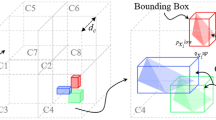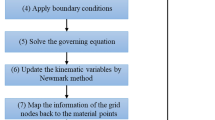Abstract
The combined finite–discrete element (FDEM) has become a well-accepted numerical technique to simulate the fracturing process of rocks under different loading conditions. However, the study on three-dimensional (3D) FDEM simulation of rock failure process is highly limited in comparison with that on two-dimensional (2D) FDEM simulations, which is due to the high computational cost of the 3D FDEM. This paper implements an adaptive contact activation approach and a mass scaling technique with critical viscous damping into a GPGPU-parallelized Y-HFDEM 2D/3D IDE code formally developed by the authors to further speed up 3D FDEM simulation besides GPGPU parallelization. It is proved that the 3D FDEM modelling with the adaptive contact activation approach is 10.8 times faster than that with the traditional full contact activation approach, while the obtained results show negligible differences. At least additional 25 times of speedups can be achieved by the mass scaling technique although further speedups are possible with bigger mass scaling coefficients chosen, which, however, will more and less affect the calculated results. Taking the advantage of the drastic speedups of the implemented adaptive contact activation approach and the mass scaling approach, the GPGPU-parallelized Y-HFDEM 3D IDE is then applied to model the fracture process of rocks in triaxial compression tests under various confining pressures. It is concluded that the GPGPU-parallelized Y-HFDEM 3D IDE is able to simulate all important characteristics of the complicated fracturing process in the triaxial compression tests of rocks including the transition from brittle to ductile behaviours of rocks with the increasing confining pressures. After that, some important aspects of the 3D FDEM simulation such as the effects of meshes, loading rates and model sizes are discussed. It is found that the mixed-mode I–II fractures are highly possible, i.e. very reasonable, failure mechanisms when unstructured meshes are used in the 3D FDEM simulation. For modelling rock fracture under quasi-static loading conditions using the 3D FDEM, the loading rate must be small enough, which is recommended to be no more than 0.2 m/s, to avoid its significant effects. Finally, it is concluded that the implementation of the adaptive contact activation approach and the mass scaling technique can further speed up 3D FDEM simulation besides the parallelization and the GPGPU-parallelized 3D IDE code with the further speedup is able to capture the complicated fracturing process of rocks under quasi-static loading conditions.














Similar content being viewed by others
References
Akram MS, Sharrock G, Mitra R (2010) Physical and numerical investigation of conglomeratic rocks. Ph. D. Thesis, University of New South Wales, Sydney, Australia
An HM, Liu HY, Han H, Zheng X, Wang XG (2017) Hybrid finite-discrete element modelling of dynamic fracture and resultant fragment casting and muck-piling by rock blast. Comput Geotech 81:322–345
Baumgarten L, Konietzky H (2013) Investigations on the fracture behaviour of rocks in a triaxial compression test. In: ISRM international symposium-EUROCK 2013. International Society for Rock Mechanics and Rock Engineering
Bažant ZP, Shang-Ping B, Ravindra G (1993) Fracture of rock: effect of loading rate. Eng Fract Mech 45:393–398
Camacho GT, Ortiz M (1996) Computational modelling of impact damage in brittle materials. Int J Solids Struct 33:2899–2938
Chen S, Wei C, Yang T, Zhu W, Liu H, Ranjith PG (2018) Three-dimensional numerical investigation of coupled flow-stress-damage failure process in heterogeneous poroelastic rocks. Energies 11:1923
Egert R, Seithel R, Kohl T, Stober I (2018) Triaxial testing and hydraulic-mechanical modeling of sandstone reservoir rock in the Upper Rhine Graben. Geotherm Energy 6:23
Euser B, Lei Z, Rougier E, Knight EE, Frash L, Carey JW, Viswanathan H, Munjiza A (2018) 3-D finite-discrete element simulation of a triaxial direct-shear experiment. In: 52nd U.S. rock mechanics/geomechanics symposium. American Rock Mechanics Association, Seattle, Washington, p 6
Fukuda D, Mohammadnejad M, Liu H, Cho S, Oh S, Min, G, Chan A, Kodama J, Fujii F (2018) GPGPU-based 3-D hybrid FEM/DEM for numerical modelling of various rock testing methods. In: 12th Australia and New Zealand Young geotechnical professionals conference, pp 1–10
Fukuda D, Mohammadnejad M, Liu H, Dehkhoda S, Chan A, Cho S-H, Min G-J, Han H, Kodama J-I, Fujii Y (2019) Development of a GPGPU-parallelized hybrid finite-discrete element method for modeling rock fracture. Int J Numer Anal Methods Geomech 43:1797–1824
Fukuda D, Mohammadnejad M, Liu H, Zhang Q, Zhao J, Dehkhoda S, Chan A, Kodama J, Fujii Y (2019) Development of a 3D hybrid finite-discrete element simulator based on GPGPU-parallelized computation for modelling rock fracturing under quasi-static and dynamic loading conditions. Rock Mech Rock Eng. https://doi.org/10.1007/s00603-019-01960-z
Gao FQ, Stead D (2014) The application of a modified Voronoi logic to brittle fracture modelling at the laboratory and field scale. Int J Rock Mech Min Sci 68:1–14
Goodman RE (1989) Introduction to rock mechanics. Wiley, New York
Guo L, Xiang J, Latham JP, Izzuddin B (2016) A Numerical investigation of mesh sensitivity for a new three-dimensional fracture model within the combined finite-discrete element method. Eng Fract Mech 151:70–91
Guo L (2014) Development of a three-dimensional fracture model for the combined finite-discrete element method. Imperial College London, London
Ha J, Grasselli G (2018) Three-dimensional FDEM modelling of laboratory tests and tunnels. In: 52nd U.S. rock mechanics/geomechanics symposium. American Rock Mechanics Association, Seattle, Washington, p 8
Hamdi P (2015) Characterization of brittle damage in rock from the micro to macro scale. Science: Department of Earth Sciences
Heinze T, Jansen G, Galvan B, Miller SA (2016) Systematic study of the effects of mass and time scaling techniques applied in numerical rock mechanics simulations. Tectonophysics 684:4–11
Horii H, Nemat-Nasser S (1986) Brittle failure in compression: splitting faulting and brittle-ductile transition. Philos Trans R Soc Lond Ser A Math Phys Sci 319:337–374
ISRM (1978) Suggested methods for determining the uniaxial compressive strength and deformability of rock materials. Int J Rock Mech Min Sci 16:137–140
Jaime MC (2011) Numerical modeling of rock cutting and its associated fragmentation process using the finite element method. University of Pittsburgh, Pittsburgh
Lisjak A, Mahabadi OK, He L, Tatone BSA, Kaifosh P, Haque SA, Grasselli G (2018) Acceleration of a 2D/3D finite-discrete element code for geomechanical simulations using general purpose GPU computing. Comput Geotech 100:84–96
Liu HY, Kang YM, Lin P (2015) Hybrid finite-discrete element modeling of geomaterials fracture and fragment muck-piling. Int J Geotech Eng 9:115–131
Liu HY, Han H, An HM, Shi JJ (2016) Hybrid finite-discrete element modelling of asperity degradation and gouge grinding during direct shearing of rough rock joints. Int J Coal Sci Technol 3(3):295–310
Liu Q, Deng P (2019) A numerical investigation of element size and loading/unloading rate for intact rock in laboratory-scale and field-scale based on the combined finite-discrete element method. Eng Fract Mech 211:442–462
Mahabadi O, Kaifosh P, Marschall P, Vietor T (2014) Three-dimensional FDEM numerical simulation of failure processes observed in Opalinus Clay laboratory samples. J Rock Mech Geotech Eng 6:591–606
Mahabadi OK, Lisjak A, Munjiza A, Grasselli G (2012) Y-Geo: new Combined finite-discrete element numerical code for geomechanical applications. Int J Geomech 12:676–688
Mardalizad A, Scazzosi R, Manes A, Giglio M (2018) Testing and numerical simulation of a medium strength rock material under unconfined compression loading. J Rock Mech Geotech Eng 10:197–211
Mohammadnejad M, Liu H, Chan A, Dehkhoda S, Fukuda D (2018) An overview on advances in computational fracture mechanics of rock. Geosyst Eng 7:1–24
Mohammadnejad M, Liu H, Dehkhoda S, Chan A (2017) Numerical investigation of dynamic rock fragmentation in mechanical cutting using combined FEM/DEM. In: 3rd nordic rock mechanics symposium—NRMS 2017. International Society for Rock Mechanics and Rock Engineering, Helsinki, Finland
Munjiza A (1992) Discrete elements in transient dynamics of fractured media. Ph.D. thesis, Swansea University, UK
Munjiza A (2004) The combined finite-discrete element method. Wiley, Chichester
Munjiza A, John NWM (2002) Mesh size sensitivity of the combined FEM/DEM fracture and fragmentation algorithms. Eng Fract Mech 69:281–295
Munjiza A, Knight EE, Rougier E (2011) Computational mechanics of discontinua, 1st edn. Wiley, London
Munjiza A, Owen DRJ, Bicanic N (1995) A combined finite-discrete element method in transient dynamics of fracturing solids. Eng Comput 12:145–174
Munjiza A, Rougier E, Knight EE (2015) Large strain finite element method: a practical course, 1st edn. Wiley, London
Paterson MS, Wong T-F (2005) Experimental rock deformation-the brittle field. Springer, Berlin
Rougier E, Knight EE, Broome ST, Sussman AJ, Munjiza A (2014) Validation of a three-dimensional Finite-Discrete Element Method using experimental results of the Split Hopkinson Pressure Bar test. Int J Rock Mech Min Sci 70:101–108
Rougier E, Knight EE, Sussman AJ, Swift RP, Bradley CR, Munjiza A, Broome ST (2011) The combined finite-discrete element method applied to the study of rock fracturing behavior in3D. American Rock Mechanics Association, New York
Ruiz G, Ortiz M, Pandolfi A (2000) Three-dimensional finite-element simulation of the dynamic Brazilian tests on concrete cylinders. Int J Numer Methods Eng 48:963–994
Santarelli FJ, Brown ET (1989) Failure of three sedimentary rocks in triaxial and hollow cylinder compression tests. Int J Rock Mech Min Sci Geomech Abstr 26:401–413
Solidity (2017) Solidity Project. http://solidityproject.com/. Accessed 14 Nov 2018
Tan X, Konietzky H, Frühwirt T (2015) Numerical simulation of triaxial compression test for brittle rock sample using a modified constitutive law considering degradation and dilation behavior. J Central South Univ 22:3097–3107
Tatone BSA (2014) Investigating the evolution of rock discontinuity asperity degradation and void space morphology under direct shear. University of Toronto (Canada)
Tatone BSA, Grasselli G (2015) A calibration procedure for two-dimensional laboratory-scale hybrid finite-discrete element simulations. Int J Rock Mech Min Sci 75:56–72
Turichshev A, Hadjigeorgiou J (2016) Triaxial compression experiments on intact veined andesite. Int J Rock Mech Min Sci 86:179–193
Turon A, Dávila CG, Camanho PP, Costa J (2007) An engineering solution for mesh size effects in the simulation of delamination using cohesive zone models. Eng Fract Mech 74:1665–1682
Xie J, Waas AM, Rassaian M (2016) Estimating the process zone length of fracture tests used in characterizing composites. Int J Solids Struct 100–101:111–126
Yan C, Jiao Y-Y (2018) A 2D fully coupled hydro-mechanical finite-discrete element model with real pore seepage for simulating the deformation and fracture of porous medium driven by fluid. Comput Struct 196:311–326
Yan C, Jiao Y-Y, Zheng H (2018) A fully coupled three-dimensional hydro-mechanical finite discrete element approach with real porous seepage for simulating 3D hydraulic fracturing. Comput Geotech 96:73–89
Zhang Z, Paulino GH, Celes W (2007) Extrinsic cohesive modelling of dynamic fracture and microbranching instability in brittle materials. Int J Numer Methods Eng 72:893–923
Acknowledgements
The corresponding author would like to acknowledge the support of the Australia-Japan Foundation (Grant No. 17/20470). The second author of this work is supported by Japan Society for the Promotion of Science KAKENHI (Grant No. JP18K14165) for Grant-in-Aid for Young Scientists, which is greatly appreciated. Moreover, all authors would like to thank the guest editor, i.e. Dr Esteban Rougier, the editor in chief and the anonymous reviewers for their constructive comments and encouragements.
Author information
Authors and Affiliations
Corresponding author
Ethics declarations
Conflict of interest
On behalf of all authors, the corresponding author states that there is no conflict of interest.
Additional information
Publisher's Note
Springer Nature remains neutral with regard to jurisdictional claims in published maps and institutional affiliations.
Rights and permissions
About this article
Cite this article
Mohammadnejad, M., Fukuda, D., Liu, H.Y. et al. GPGPU-parallelized 3D combined finite–discrete element modelling of rock fracture with adaptive contact activation approach. Comp. Part. Mech. 7, 849–867 (2020). https://doi.org/10.1007/s40571-019-00287-4
Received:
Revised:
Accepted:
Published:
Issue Date:
DOI: https://doi.org/10.1007/s40571-019-00287-4




